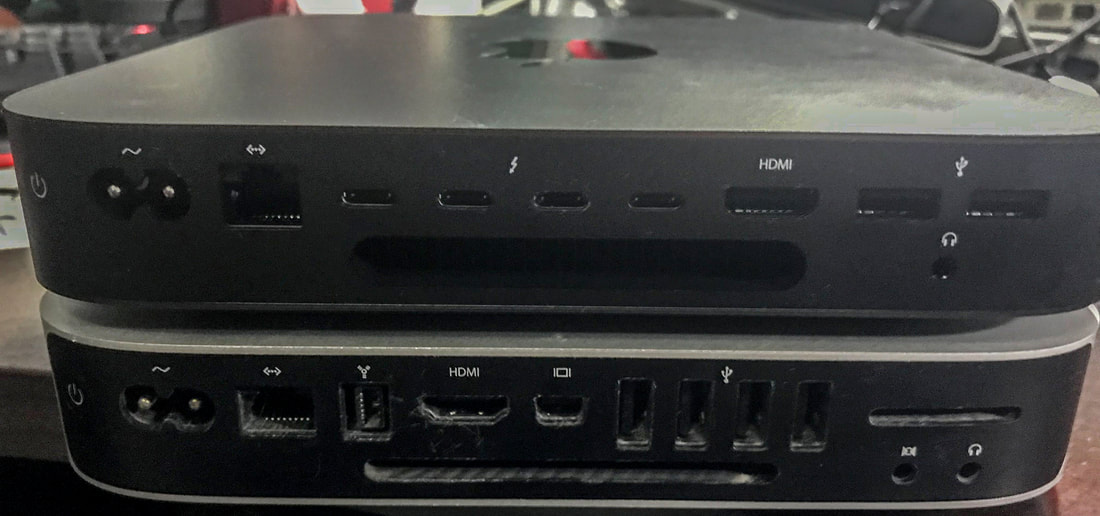(NOTE: The pic above shows the 2018 Mini on top of the 2010 Mini)
5. Future Use - While the iMac is nice while it is your main computer, it has limitations for secondary use. I know because I have moved a 2010 Mac Mini and 2011 iMac from my desk in the last 8 months. With the Mac Mini, I simply unplugged it and connected it to my main home theater system. It is used as a server and for bit perfect audio. It also added web browsing to the big screen. The iMac, on the other hand, is difficult to move. You can’t just pop it into an entertainment system, closet, or into an audio setup to reap the benefits. It is too large. For now, I cleared off some shelves in my office and will use it as a “standing desk” for when I just want to get off my butt and use it for browsing the web or something. The fact is that I struggled to find a use for it and it isn’t worth selling. We may eventually find a place near our kitchen to put it, but so far, we haven’t come up with any great ideas.
4. Ports - The iMac has 2 Thunderbolt 3 ports. The Mini has 4. The only advantage to the iMac is the SD card slot, but it is slow and hard to reach. I would rather have something I can access easier that plugs into the USB-C port. Currently, I use an adapter that has a card reader and a bunch of USB ports.
3. Display Options - with the Mac Mini, I can use any monitor I want. Yes, If you like the 5k, 27 inch monitor on the iMac, maybe that is the route to go. However, I wanted an ultra wide monitor and was tired of the 27 inch form factor. It seems like we have seen pretty much the same form factor in the iMac forever. Other than trimming some width (Big deal), there isn't much difference in the old and new versions.
2. Entry Level Price - If you already have a monitor, keyboard and mouse, you can get into a Mac Mini for a lot less money. I see the iMac as a great buy if you can live with the restraints related to the screen, but you can’t buy one for anywhere close to the entry price of the Mini. The entry level price of the Mini is $799, the cheapest iMac is $1099 and that is with an archaic spinning hard drive and a small 21.5 inch, 1920x1080 screen. Add SSD (no 128GB option) and it goes up another $200. If you just want an entry level computer for running MacOS, the choice is obvious because I would rather buy a larger screen with the price differential. Which is a better buy is a different question and it would depend on your needs.
1. iMac has a limited monitor - The main reason I personally dislike the iMac monitor isn’t just related to the form factor or the lack of size configurations. It has more to do with the inputs. It simply doesn’t have the input options. Yes, you can use target display with another Mac, which is nice, but that’s it. I want to use my main monitor to connect to a receiver for watching all my entertainment devices…AppleTV, Roku, Chromecast, Shield,Tivo, etc. I also want an input for my Dell PC for gaming. I know my situation isn’t the norm, but this is one of the most important factors for me. I have a 32 inch 4k monitor I have been using on an arm alongside my iMac and I ended up using it more than the iMac display that was in the center of my desk.
To be fair, the iMac is a great option for people that have never owned a computer before because it gives you a mouse, keyboard and monitor with the computer. However, it isn’t ideal for my needs.
The only thing I would like available in a Mini that the iMac has is a better GPU. The one in the Mini is garbage. Most of those differences can be minimized by adding an external GPU via the Thunderbolt 3 port, though. I knew this going in, but I figured I could live with the onboard graphics until I had the money and need for an eGPU. The great thing about adding it externally is you can add it later or upgrade as prices drop or as new cards are supported.
I will probably add the Vega 54, which will be more than enough for my needs, when prices drop closer to Christmas, but that isn’t set in stone, so I will see how it goes. I haven’t been shooting enough video lately to make the extra expenditure worth the money and it is solving a problem I currently don’t have. The other upside is that if I want to use the eGPU with my MBP, I can just unplug the Mini and plug the eGPU into the MBP. That may come in handy for when I start a Final Cut workflow on the road or on my couch and want to just wrap up the process in my office without having to move files. That isn’t possible with an iMac unless you add an external GPU, which would be kind of unusual since it already comes with discreet graphics.
As you can see, there are plenty of reason to still prefer the mini over Apple’s latest iMac. Hopefully, it will continue to get spec bumps, but even without them, it is a very capable machine with tons of flexibility for people that favor those attributes.

 RSS Feed
RSS Feed